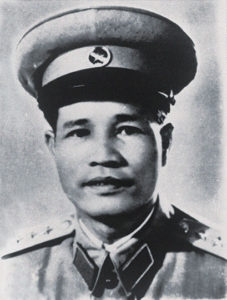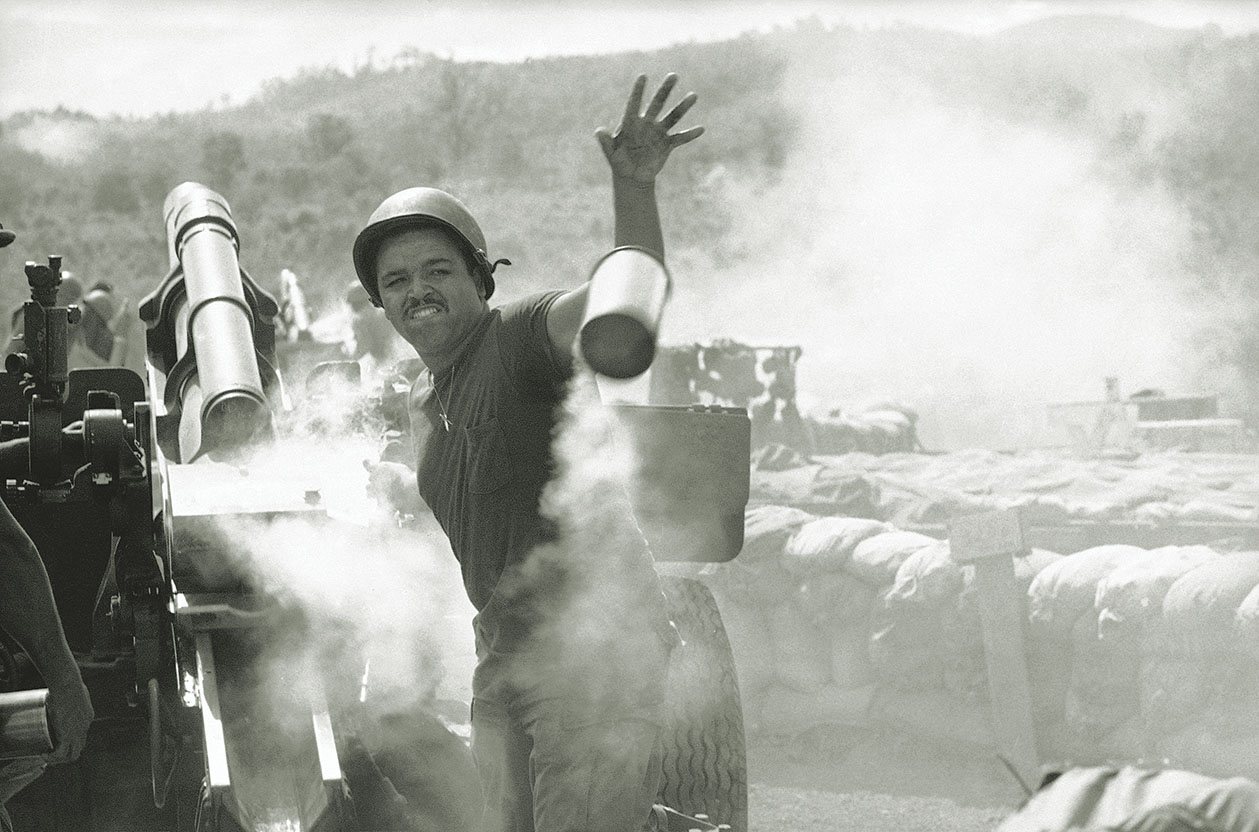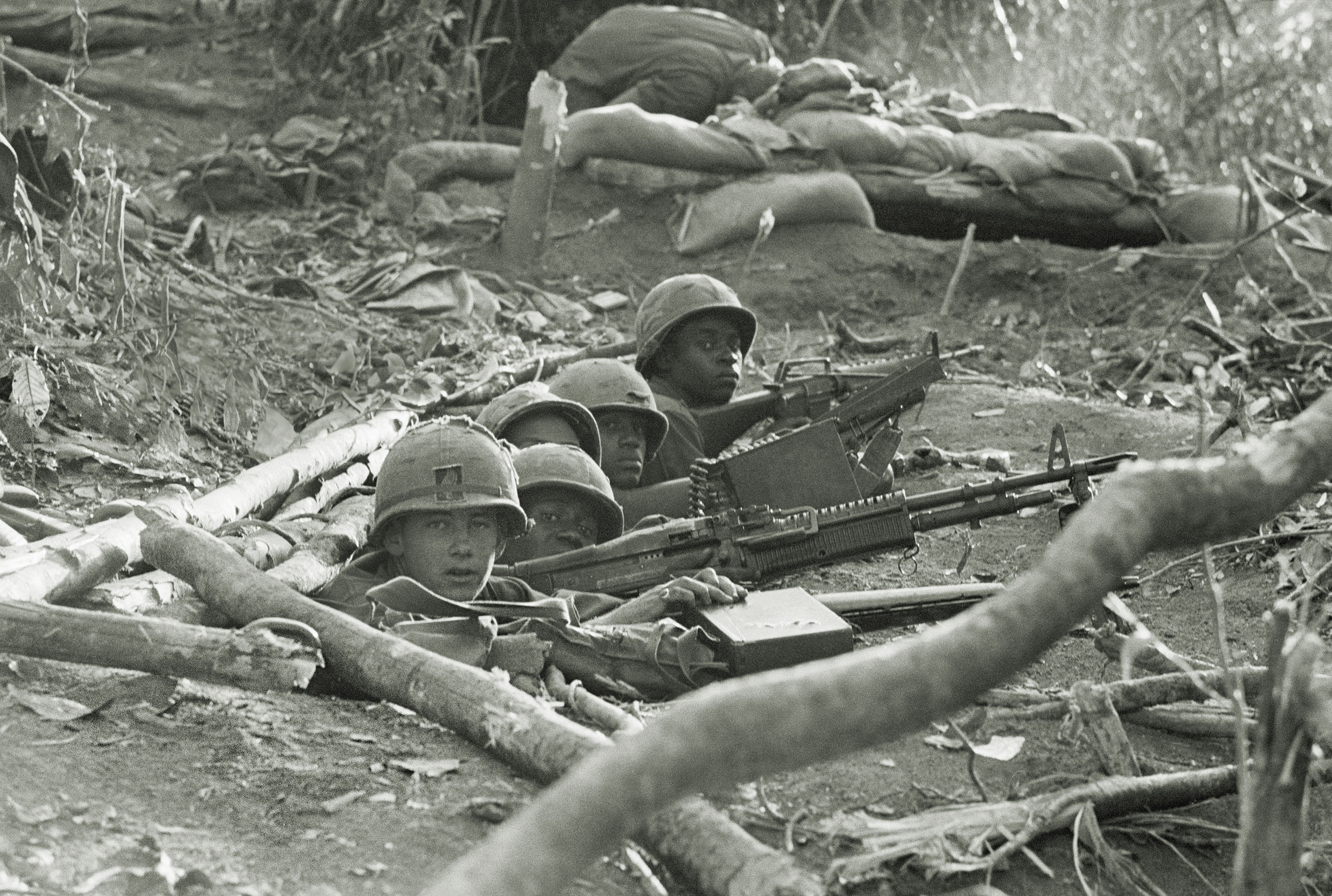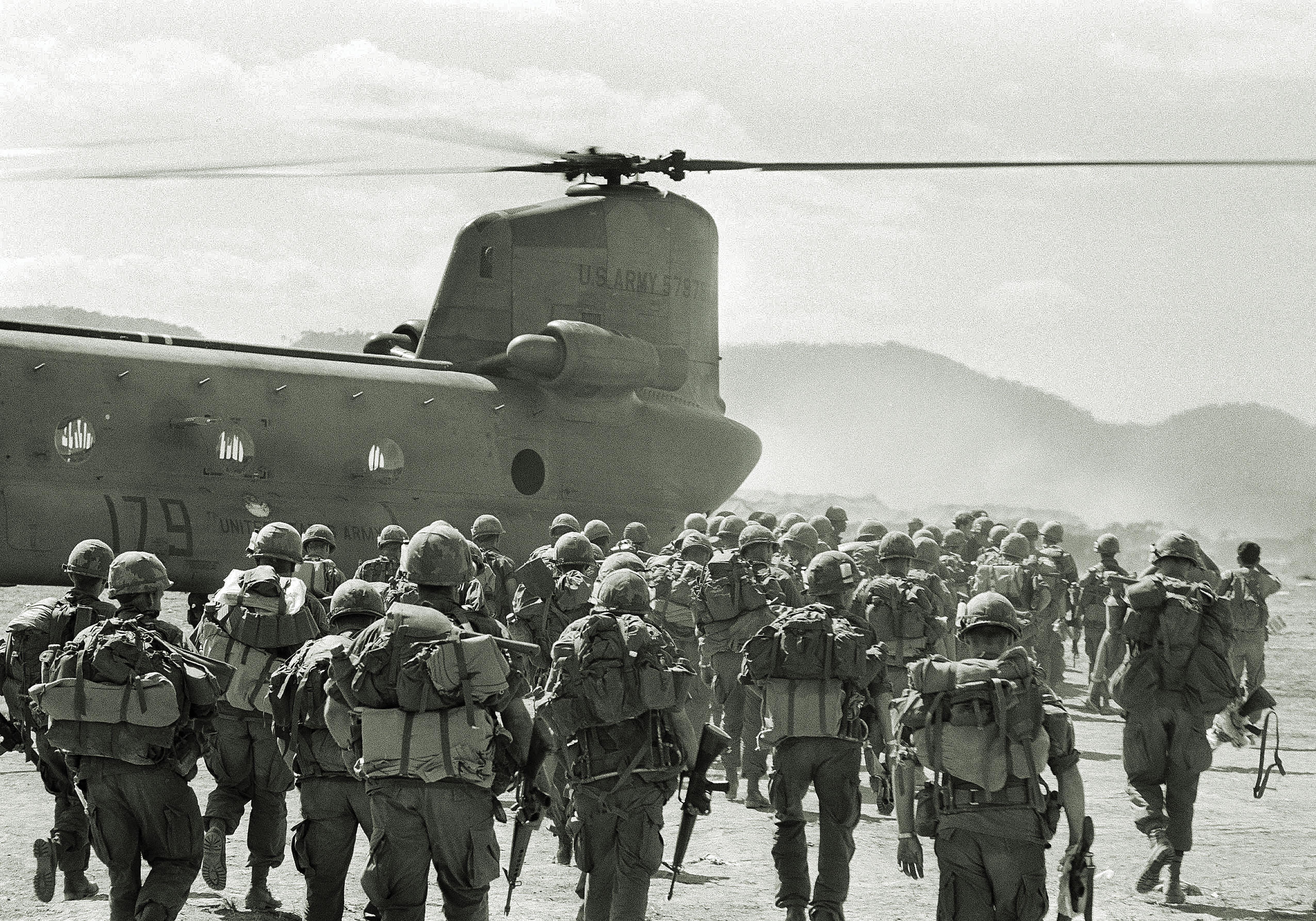In accounts of the November 1967 battle of Dak To, one of the largest and longest battles of the Vietnam War, the center of attention is often the elite 503rd Infantry Regiment (Airborne) of the 173rd Airborne Brigade, assigned prior to the battle to the 4th Infantry Division. Seemingly forgotten is the fight waged by the division’s “leg” (non-airborne infantry), engineer and artillery units.
That’s a sore spot for some veterans who were at Dak To.
“The 173rd were good soldiers and they did their fair share; they certainly did no more than the many other ‘non-elites’ did, like the 4th Division grunts, the artillery and others,” said Steve Stark, an artillery liaison specialist assigned to the 6th Battalion, 29th Field Artillery Regiment, 1st Brigade, at Dak To, in an article by Tim Dyhouse for VFW Magazine.
The 4th Infantry Division—nicknamed the Ivy Division for the pronunciation of the unit’s number in Roman numerals, IV—was led by Maj. Gen. William Peers. It comprised the 1st, 2nd (Mechanized) and 3rd battalions, 8th Infantry Regiment, commanded by Lt. Col. Glen Belnap, and the 1st and 3rd battalions, 12th Infantry Regiment, under Lt. Col. John Vollmer. Supporting the missions at Dak To were 15 artillery batteries in the division.
The battle was a collection of fights waged simultaneously against the North Vietnamese Army and Viet Cong from Nov. 3 to Nov. 23 on several hills near the Central Highlands town of Dak To in Kontum province, close to the point where the borders of Laos, Cambodia and South Vietnam meet. In the most high-profile fight, the 173rd Airborne battled for control of Hill 875. However, units of the 4th Infantry Division were the first to make contact with the enemy when they fought the NVA on Nov. 3 and 4 around Hill 1338. (Hills were numbered based on their height in meters.)
The Dak To area, with its thick jungle and steep mountain ridges, was a particularly hellish location for a battle. Tangled thickets of vines and thorns lay in the valleys between the ridges—all of them full of snakes, leeches and enemy fighters.
Within this tangled mess, the North Vietnamese had established a base camp, designated Base Area 609, linked by the Ho Chi Minh Trail to a command center in Hanoi. Countering the communist presence in the area were camps where small contingents of U.S. Special Forces, the Green Berets, trained and assisted militias of local hill tribes organized as Civilian Irregular Defense Groups. These CIDG camps were constantly attacked by NVA and Viet Cong forces.
The 4th Infantry Division had overall command of Kontum province and Pleiku province to the south as well as the northern portion of Darlac, the province below Pleiku. Spread over such a large territory, the division could send to Kontum province only one mechanized battalion (a unit that transports infantry to the battlefield in armored tracked vehicles): the 2nd Battalion, 8th Infantry (Mechanized).

To get to Dak To from Pleiku city, U.S. troops followed Route 14 north through Kontum city and then turned west on Route 512.
“North of Dak To, Route 14 rapidly deteriorated as it approached a CIDG camp at Dak Seang,” wrote Allay Sandstrum in “Three Companies at Dak To,” a chapter in Seven Firefights in Vietnam.
“Still farther to the north, the road became so poor that another camp at Dak Pak had to rely solely on an aerial life line.”
The NVA’s objective was simple: Sweep all American forces and Army of the Republic of Vietnam troops from the Central Highlands. If the North Vietnamese succeeded, they would have a clear path into South Vietnam for attacks on cities and U.S.-ARVN military installations as part of a planned Tet Offensive in early 1968 that the communists hoped would deliver devastating blows all across the country.
Under a strategy developed by Gen. Nguyen Chi Thanh, the NVA would first isolate and destroy brigade-size or smaller American units positioned at or near Dak To. Those engagements, Thanh believed, would slowly drain the strength of U.S. forces and compel American commanders to send in reinforcements from other areas, thus weakening the defenses in the locations they left and creating more openings for communist troops during the Tet Offensive.
To implement that strategy, the NVA planned to deploy its 24th, 32nd, 66th and 174th regiments from the NVA 1st Division, a total of about 6,000 men. Those units would use “hit and run” tactics, basically running in from Cambodia and Laos to do as much damage as possible and then retreat back across the border, out of range of American firepower.
The North Vietnamese forces were under the overall command of Maj. Gen. Hoang Minh Thao and political officer Col. Tran The Mon.
By the end of October 1967, bits and pieces of information trickling into U.S. officials from the CIDG camps and reconnaissance patrols indicated the communists were preparing for something. Intelligence sources revealed that the NVA’s 1st Division was moving the bulk of its forces from the Cambodian border and remote locations in the Central Highlands toward Kontum province. This large-scale transfer of troops forced the Americans to counter the NVA’s move, like playing a deadly game of chess.
On Oct. 28, the 4th Infantry Division replaced its mechanized battalion with the 3rd Battalion, 12th Infantry Regiment, using foot soldiers to more effectively locate the enemy. Long-range reconnaissance patrols reported enemy movement toward Dak To from the southwest.
The 1st Brigade, 4th Infantry Division, commanded by Col. Richard Johnson, moved its headquarters to Dak To, closer to the action, and brought in the 3rd Battalion, 8th Infantry Regiment, to strengthen its forces. The recon teams, with the aid of airborne surveillance devices, kept track of enemy movements and spotted recently established base camps loaded up with ammunition caches.
Lt. Gen. William Rosson, commanding general of U.S. forces in the central South Vietnam region, called in the airborne troops of the 4th Battalion, 503rd Infantry, airlifting the men to Dak To from Phu Yen province on the coast. That boosted U.S. strength to three battalions totaling around 4,500 men as of Nov. 1.
As American combat units moved into place, the 4th Infantry Division also brought in Company D, 704th Maintenance Battalion; Company B, 4th Medical Battalion; 1st Platoon, 4th Military Police Company; communications personnel from the 124th Signal Battalion and an attached engineer platoon from the 299th Engineer Battalion. All of the elements for sustained combat were in place. The only thing missing was up-to-date intelligence on enemy activities.
Good fortune shone upon U.S. forces when a North Vietnamese sergeant in the 66th Regiment, Vu Hong, surrendered in the village of Bak Ri, near Route 512, north of Dak To. Hong said his 50-man unit had been selecting firing positions for mortars and 122 mm rocket launchers. He also said five regiments were converging on Dak To and the CIDG camp at Ben Het, just west of Dak To.
The plan, as Hong relayed it, called for a southwest to northeast attack. The NVA 32nd and 66th regiments, with the support of the NVA 40th Artillery Regiment, were to spearhead the assault. The NVA 66th Regiment was southwest of Dak To, and the 32nd Regiment moved from the southwest to Dak To to prevent an American counterattack that could come from the base. The NVA 24th Regiment would set up northeast of Dak To, in Tan Canh, and act as a blocking force to prevent American forces from escaping. The 174th Regiment was to stand by as a reserve unit.
With the new intelligence in hand, Lt. Col. James Johnson, commander of the 4th Battalion, 503rd Infantry, ordered his men to set up a firebase at the Ben Het CIDG camp. The NVA, perhaps surprised by the fast response of U.S. forces, pulled back to defensive positions and waited. The NVA 66th Regiment moved to high ground southwest of Ben Het. Johnson, seeing an opportunity to stop the NVA in its tracks, moved the 503rd Infantry to meet the enemy. Holding the high ground, the North Vietnamese waited.
At the same time Belnap, the commander of the 3rd Battalion, 8th Infantry, sent companies B and C to the southwest, and Vollmer, leading the 3rd Battalion, 12th Infantry, deployed his A and B companies, which were airlifted to Ngok Ring Rua Mountain south of Dak To. The 12th Infantry battalion would set up a firebase, and the 8th Infantry battalion was to establish a position along the trail to the Dak Hodrain River Valley and stop the flow of enemy traffic to that area.
The Americans intended to launch an offensive strike on the North Vietnamese before the enemy troops could fully dig in for their offensive. Units of the two 4th Infantry Division battalions initiated contact, in separate encounters, with troops of the NVA 32nd Regiment on Nov. 3 and 4 just south of the Dak To CIDG camp.
Thanks to artillery and air support, U.S. casualties were relatively light. Companies B and C of the 3rd Battalion, 8th Infantry, got into position along the main trail to the Dak Hodrain River Valley with no resistance. They quickly moved to establish a patrol base for search-and-destroy missions on Hill 785.
On the morning of Nov. 4, while moving toward Hill 882, Company A, 3rd Battalion, 8th Infantry, came under automatic weapons fire from an enemy platoon. Taking defensive positions, the Company A soldiers returned fire, pinning down the enemy. At the same time artillery and airstrikes were called in, eliminating the threat. On Nov. 5 companies A and D, 3rd Battalion, 8th Infantry, swept Hill 882, with no further direct contact. However, as the Americans approached Hill 843, they came under fire from communist B-40 rockets and 60 mm mortars.
Arriving on Hill 843, the two companies dug in. Throughout the night and early morning of Nov. 7 and 8, the NVA fired rockets and mortar rounds into the American position. On the morning of Nov. 8, Company A moved to take Hill 724, while Company D remained in place to secure the position at Hill 843.
When Company A neared a small knoll, the North Vietnamese opened up with machine guns and automatic rifle fire, pinning the Americans in place—a bad situation that worsened when the NVA sent rockets and 82 mm mortar fire into the position.
Company A was reinforced by Company D, which moved north to flank the enemy. The NVA turned its fire toward the new threat, pinning down the arriving company but allowing Company A to break contact and maneuver to aid Company D. Under heavy automatic fire accompanied by continuous rocket and mortar attacks, the two companies linked up and slowly moved forward. In the afternoon of Nov. 8, they made a final rush, took the knoll and dug in.

At 8 p.m., the NVA attempted to take the knoll back. A fierce battle ensued, with the NVA infantrymen again supported by rockets and mortars. The North Vietnamese breached the American perimeter but were pushed back by the combined efforts of the defenders, as well as artillery and airstrikes. One of the airstrikes, called in by an Air Force strike coordinator embedded with the two infantry companies, hit within 50 feet of the companies’ positions. By late evening the enemy’s attack ceased, though constant suppressive fire lasted through the night.
The two American companies suffered 21 soldiers killed and 81 wounded.
Company A, which had borne the brunt of the fighting, was pulled out on Nov. 10 and replaced by companies B and C of the 8th Infantry’s 3rd Battalion. Early on Nov. 11, Company B secured a landing zone for medevacs, while companies C and D resumed the battalion’s fight to seize Hill 724. The hill was taken without any major contact.
Company B moved out to join the other two companies. As it neared the perimeter of companies C and D, the NVA, lying in wait, launched a fierce attack. Rockets and mortar rounds rained down on the perimeter as waves of North Vietnamese fighters hurled themselves at the American defenders, engaging all three companies. The weary Americans called in artillery and air support, which drove back the NVA. The battle had lasted two hours. It was later determined that companies B, C and D of the 3rd Battalion, with the aid of artillery and air support, had beaten back two battalions of the 32nd NVA Regiment. When the shooting stopped, the 8th Infantry had suffered 18 killed and 118 wounded.
While the 8th Infantry was fighting running battles near the Dak Hodrain River Valley, the 12th Infantry troops were busy in the Ngok Ring Rua Mountains where they were airlifted on Nov. 3.
At 3:52 p.m., on Nov. 3, the 12th Infantry’s Company B, 3rd Battalion, ran into an NVA platoon firing from an extensive bunker and trench system laid along a trail. The American infantrymen needed to breach the NVA bunker defenses so they could set up a firebase that would be used for an attack on nearby hills.
After getting a fix on the enemy position, Company B broke contact and called in artillery support from the 4th Infantry Division’s Battery B, 6th Battalion, 29th Field Artillery.
After the artillery peppered the area with 105 mm shells, Company B moved forward. Its troops were soon greeted by B-40 rockets and 60 mm mortar fire. The company pulled back and again called in artillery and air support, which was supplied by 40 aircraft.
Early in the morning of Nov. 4, Company B’s 3rd Platoon attempted to knock out the bunker. Suddenly the platoon was attacked, cut off from the rest of the company and pinned down with rocket and mortar fire. After heavy fighting, two squads from 1st Platoon fought their way to their entrapped colleagues. At 2 p.m., 3rd Platoon was able to link up with the rest of Company B. Artillery and airstrikes were called in again. The bombardment knocked out the bunker, and on Nov. 5, Company B was finally able to move forward and secure the position.
From Nov. 6 to 14, the 3rd Battalion, 12th Infantry, fought to clear enemy positions on the hills of the Ngok Kon Kring Ridge, which overlooked the Dak To base. In attacks on hills 1124, 1089 and 1021 the battalion found heavily fortified bunkers and trench complexes, an indication the enemy intended to stay. The Americans were repeatedly hit with fire from machine guns, B-40 rockets and 60 mm mortars. Despite heavy fighting, the hills were taken.
On Nov. 16, companies A and C of the 3rd Battalion, 12th Infantry, advanced on Hill 1338. Running into a heavily entrenched NVA force firing rockets and mortars, they called for artillery and air support. Artillery shelling and surgical strikes from U.S. Air Force fighter-bombers pounded the target throughout the night. On the morning of Nov. 17, Company C attempted another advance and was again met with intense fire, despite the heavy bombardment of the previous night.
While Company C continued its slow advance, Company A positioned itself to the southwest and established a firebase. Hill 1338 was finally taken and secured as darkness fell. A search of the area on Nov. 18 revealed that the two companies had fought their way through an extensive defensive system of trench lines, bunkers and firing positions.
The 3rd Battalion turned its attention to hills 1262 and 1245 in battles waged Nov. 19-21. As the Americans pressed ahead, the enemy began a withdrawal but continued to fight intense delaying battles. Despite heavy fighting, the Americans were able to clear and secure Ngok Kon Kring Ridge.

During these multiple engagements, Army intelligence operatives detected structures that looked like a North Vietnamese headquarters area, just a short distance from the Cambodian border and safe havens on the other side. That area, known as “Dogbone Hill,” was a convenient place to fire mortars and rockets into the American base at Dak To.
The 1st Battalion, 8th Infantry, was chosen to attack Dogbone Hill in an operation that consisted of companies A, C and D, an attached engineer platoon and a small command group.
After Dogbone Hill was blasted by artillery and airstrikes, the 1st Battalion units were helicoptered to the hill, quickly occupied the area and established a fortified defensive position, a speedy accomplishment that brought praise from Peers, the 4th Infantry Division commander.
The withdrawing North Vietnamese were moving west toward Cambodia, U.S. intelligence reported. The 4th Infantry Division command countered with moves to thwart the escape. On Nov. 14, B and C companies of the 3rd Battalion, 8th Infantry, established a position on Hill 762 to block an NVA exit through the Dak Sir Valley, south of Dak To.
On Nov. 15, companies B and D of the 3rd Battalion, 12th Infantry, established a position on Hill 530. The American occupation of hills 762 and 530 put a blocking force at the intersection of three key escape routes leading to Cambodia: the Dak Hodrai, Dak Sir and Dak Romao valleys, all south/southwest of Dak To.
Those American-held hills were used to conduct extensive search-and-destroy operations, but there were few contacts with the enemy. Were the NVA forces hiding or had they managed to escape?
The answer came on Nov. 17 when the NVA assaulted the 1st Battalion, 8th Infantry, firebase on Dogbone Hill. The North Vietnamese hit the base with fire from automatic weapons, 82 mm mortars and 122 mm rockets. This NVA attempt to break free from the trap set by American positions on the hills surrounding Dak To lasted 10 days. In that time more than 500 enemy rounds landed on or around Dogbone Hill. On Nov. 19, a Company C patrol attacked the retreating the enemy. The NVA disengaged and fled the area. An inspection of the site revealed a large number of weapons and more than 2 tons of rice.
All of the American objectives were achieved, but at what cost? The Battle of Dak To claimed 376 Americans killed and 1,441 wounded. Of the 3,200 paratroopers deployed by the 173rd Airborne 27 percent were either killed (208) or wounded (645), with the rifle companies suffering 90 percent of the unit’s casualties.
The heavy combat throughout November strained not only the fighting forces of the 4th Infantry Division but also the doctors and nurses in the division’s 4th Medical Battalion. The medical staff in the field treated about 1,200 wounded American and ARVN soldiers during the weeks of continuous battle and managed to keep them alive while waiting for the evacuation helicopters to arrive.
“Every wounded soldier reached the 71st Evac Hospital at Pleiku alive,” stated William J. Shaffer, executive officer of Company B, 4th Medical Battalion, in Dyhouse’s article for VFW Magazine.
The legendary elite units, often the focus of battle tales popular with the public, are not the only ones that make vital contributions in combat—as the battle of Dak To shows. V
Dana Benner holds a master’s degree in heritage studies. He teaches history, political science and sociology at the university level. Benner served more than 10 years in the U.S. Army. He lives in Manchester, New Hampshire.
This article appeared in the October 2021 issue of Vietnam magazine.






